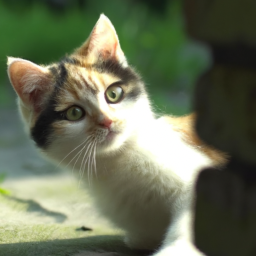Unleash the Mystery: Exploring the Enigmatic World of Cats
Introduction
Cats have long been a subject of curiosity and fascination for humans. From their mysterious behaviors to their unique physical features, there are many aspects of cats that pique our interest. Whether it’s their ability to always land on their feet or their enigmatic communication methods, cats continue to captivate us with their intriguing nature. In this introduction, we will explore some of the curiosities about cats that have intrigued humans for centuries.
The Mysterious Origins of Domestic Cats
The Mysterious Origins of Domestic Cats
Cats have long been a source of fascination for humans. With their graceful movements, independent nature, and enigmatic behavior, it’s no wonder that they have captured our attention for centuries. But have you ever wondered where domestic cats actually come from? The origins of these mysterious creatures are shrouded in mystery and intrigue.
One theory suggests that domestic cats are descendants of the African wildcat, scientifically known as Felis lybica. This wildcat is native to Africa, the Middle East, and parts of Asia. It is believed that ancient Egyptians were the first to domesticate these wildcats, as early as 4,000 years ago. The Egyptians revered cats and even worshipped a cat goddess named Bastet. They believed that cats brought good luck and protection, which is why they were often depicted in their artwork and buried alongside their owners.
Another theory proposes that domestic cats originated in the Near East, specifically in the Fertile Crescent region. This area, which includes modern-day Iraq, Syria, and Turkey, is considered the birthplace of agriculture. As humans transitioned from a nomadic lifestyle to settled farming communities, they inadvertently created an environment that attracted rodents. Cats, with their hunting skills, were drawn to these settlements, where they found a steady supply of food. Over time, these wildcats became more comfortable living alongside humans, leading to their domestication.
Regardless of their exact origins, it is clear that cats have had a long and complex relationship with humans. They were not only valued for their hunting abilities but also for their companionship. In ancient Rome, cats were kept as pets and were even considered a status symbol among the wealthy. They were also believed to have supernatural powers and were associated with witchcraft during the Middle Ages, leading to their persecution and mass killings.
Interestingly, the domestication of cats was a gradual process that occurred independently in different parts of the world. In ancient China, for example, cats were domesticated around the same time as in Egypt. However, they were primarily kept for their ability to catch rats and mice, rather than as pets. In Japan, cats were introduced by Buddhist monks to help protect valuable manuscripts from rodents. These early interactions between humans and cats laid the foundation for the deep bond that exists between them today.
Despite their domestication, cats have retained many of their wild instincts. They are skilled hunters, capable of catching prey with precision and agility. Even well-fed domestic cats will instinctively stalk and pounce on toys or insects, displaying their natural hunting behavior. This is one of the reasons why cats are often seen as mysterious creatures, as they possess a mix of domestication and wildness that sets them apart from other pets.
In conclusion, the origins of domestic cats are a fascinating topic that continues to intrigue researchers and cat lovers alike. Whether they descended from African wildcats or emerged independently in different parts of the world, cats have played a significant role in human history. From their revered status in ancient Egypt to their association with witchcraft in the Middle Ages, cats have left an indelible mark on our culture. Today, they continue to captivate us with their mysterious nature and unique personalities, reminding us of the enduring bond between humans and these enigmatic creatures.
Unusual Cat Behaviors Explained

Cats are fascinating creatures that have captivated humans for centuries. Their mysterious and independent nature often leaves us wondering about their behaviors. From their peculiar habits to their unique ways of communicating, cats never fail to surprise us. In this article, we will explore some of the most unusual cat behaviors and attempt to shed light on the reasons behind them.
One common behavior that many cat owners have observed is kneading. Kneading is when a cat rhythmically pushes their paws against a soft surface, such as a blanket or their owner’s lap. While it may seem strange, this behavior is actually rooted in a cat’s instinctual behavior as a kitten. When kittens nurse, they knead their mother’s belly to stimulate milk flow. As adult cats, they may continue this behavior when they feel content or relaxed, as it reminds them of their nurturing days.
Another curious behavior exhibited by cats is their obsession with boxes. It seems that no matter the size or shape, cats are irresistibly drawn to boxes. This behavior can be traced back to their instinctual need for security and protection. In the wild, cats seek out small, enclosed spaces to hide from potential predators. Boxes provide a similar sense of security, allowing cats to observe their surroundings while feeling safe and hidden.
Have you ever noticed your cat staring at something intently, seemingly fixated on an invisible object? This behavior, known as “staring into space,” can be quite perplexing. However, it is believed that cats possess a heightened sense of hearing and sight, allowing them to detect even the slightest movement or sound. So, when your cat appears to be staring at nothing, they may actually be focused on a tiny insect or the sound of a distant noise that is imperceptible to us.
One behavior that can be both amusing and confusing is the “zoomies.” The zoomies refer to the sudden bursts of energy that cats experience, where they sprint around the house, leaping and pouncing on anything in their path. This behavior is most commonly seen in young cats and is a way for them to release pent-up energy. It can also be a sign of happiness and contentment, as cats often engage in the zoomies after a satisfying meal or play session.
Cats are notorious for their love of knocking things off surfaces, such as tables or shelves. While this behavior may seem mischievous, it actually serves a purpose. Cats have a natural hunting instinct, and knocking objects off surfaces mimics the act of swatting at prey. Additionally, cats may knock things over to get their owner’s attention or to create a sense of control over their environment.
Lastly, let’s discuss the strange behavior of bringing “gifts” to their owners. Cats are known to present their owners with dead animals, such as mice or birds. While this behavior may seem unpleasant to us, it is actually a sign of affection and a display of their hunting prowess. Cats view their owners as part of their family and are simply sharing their catch as a gesture of love and appreciation.
In conclusion, cats are full of peculiar behaviors that often leave us scratching our heads. However, by understanding the reasons behind these behaviors, we can gain a deeper appreciation for our feline friends. From kneading and box obsession to staring into space and the zoomies, each behavior serves a purpose rooted in a cat’s instincts and natural behaviors. So, the next time your cat exhibits an unusual behavior, remember that there is often a fascinating explanation behind it.
Fascinating Facts about Cat Communication
Cats are fascinating creatures, known for their mysterious and independent nature. One of the most intriguing aspects of cats is their unique way of communicating. While they may not speak our language, they have a complex system of communication that is both subtle and fascinating.
One of the most well-known forms of cat communication is purring. We often associate purring with contentment, but it can also indicate other emotions such as fear or pain. Cats purr by vibrating their vocal cords, and this soothing sound can have a calming effect on both the cat and its human companions.
Another interesting form of communication is the tail. A cat’s tail can convey a wide range of emotions and intentions. For example, a tail held high and straight indicates confidence and happiness, while a puffed-up tail is a sign of fear or aggression. Cats also use their tails to communicate with other cats, often wrapping their tails around each other as a sign of friendship.
Cats are also known for their unique vocalizations. While dogs may bark or howl, cats have a more varied repertoire of sounds. From the familiar meow to the trill, chirp, and even the growl, each sound has a specific meaning. For example, a short, high-pitched meow is often a greeting, while a long, low growl is a warning sign.
In addition to vocalizations, cats also communicate through body language. They use their ears, eyes, and posture to convey their emotions. When a cat’s ears are forward and relaxed, it is usually a sign of contentment. However, if the ears are flattened against the head, it can indicate fear or aggression. Similarly, dilated pupils can indicate excitement or fear, while narrowed pupils can be a sign of aggression.
Cats also communicate through scent. They have scent glands located on various parts of their bodies, including their cheeks, paws, and tail. When a cat rubs against an object or a person, it is marking its territory with its scent. This behavior is known as bunting and is a way for cats to communicate with other cats and establish their presence.
Interestingly, cats also communicate through their whiskers. Whiskers are highly sensitive and can detect even the slightest changes in their environment. They help cats navigate in the dark and gauge the size of openings. When a cat’s whiskers are relaxed and facing forward, it is usually a sign of curiosity or interest. However, if the whiskers are pulled back tightly against the face, it can indicate fear or aggression.
Understanding cat communication can help us better understand and bond with our feline friends. By paying attention to their body language, vocalizations, and other forms of communication, we can respond to their needs and provide them with a safe and comfortable environment.
In conclusion, cats have a fascinating system of communication that involves purring, tail movements, vocalizations, body language, scent marking, and even whisker positioning. By observing and understanding these forms of communication, we can deepen our connection with our feline companions and ensure their well-being. So the next time you interact with a cat, pay attention to their subtle cues and enjoy the unique language of these curious creatures.
Q&A
1. Why do cats purr?
Cats purr as a way to communicate contentment, relaxation, or even to self-soothe when they are stressed or in pain.
2. Can cats see in the dark?
Yes, cats have excellent night vision due to their specialized eyes. They have a higher number of rod cells in their retinas, which are responsible for low-light vision.
3. Why do cats knead?
Kneading is a behavior commonly seen in cats, where they push their paws in and out against a soft surface. It is believed to be a leftover instinct from kittenhood when they would knead their mother’s mammary glands to stimulate milk production.
Conclusion
In conclusion, cats have long been a subject of curiosity for humans. Their mysterious and independent nature, along with their unique behaviors and abilities, continue to captivate and intrigue us. From their exceptional agility and hunting skills to their enigmatic communication methods, cats have a way of keeping us fascinated. Additionally, their ability to always land on their feet and their keen senses only add to the list of curiosities surrounding these enigmatic creatures. Overall, cats remain a source of wonder and fascination, leaving us with a multitude of curiosities yet to be fully understood.



